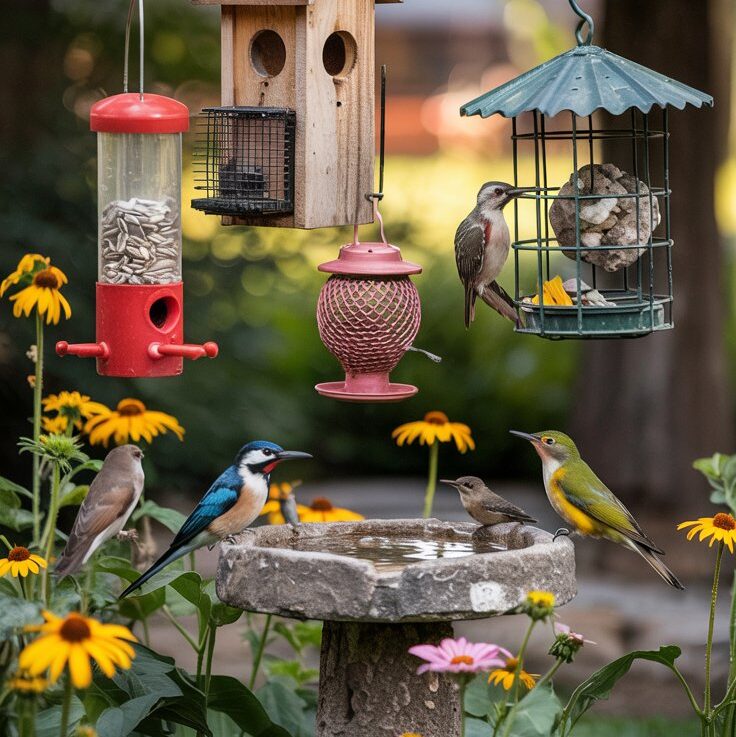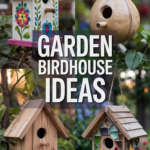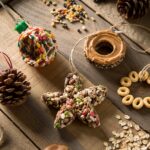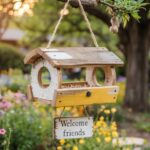Have you ever wondered how to attract more birds to your backyard? Feeding birds is a fun and rewarding hobby that connects you with nature right outside your window.
With the right food and feeders, you can create a bird-friendly space that will bring colorful visitors year-round.
Starting a bird feeding station doesn’t have to be complicated or expensive. Many beginners make simple mistakes that can be easily avoided with some basic knowledge.
In this article, we’ll share 12 essential tips that will help you create a successful feeding area for your feathered friends and maximize your bird-watching enjoyment.
1) Start With a Simple Tube Feeder for Seed Blends

If you’re new to bird feeding, a tube feeder is your perfect starting point! These cylindrical feeders have small perches and feeding ports along the sides where birds can easily access seeds.
Tube feeders work with a variety of seed blends, making them versatile for attracting many different backyard birds. They’re also relatively inexpensive and easy to find at garden centers or online stores.
For best results, hang your tube feeder about 5-6 feet off the ground in a spot that’s visible from your window but close to trees or shrubs. This gives birds a quick escape route if predators approach.
Remember to empty old seed before adding new seed to prevent mold growth. Regular cleaning every few weeks will keep your feathered friends healthy and coming back for more!
Why We Love It: Tube feeders are perfect for beginners because they’re low-maintenance, affordable, and attract a wide variety of common birds like chickadees, finches, and cardinals. They also help keep larger birds and squirrels from hogging all the food!
2) Offer Suet in a Cage Feeder for Woodpeckers
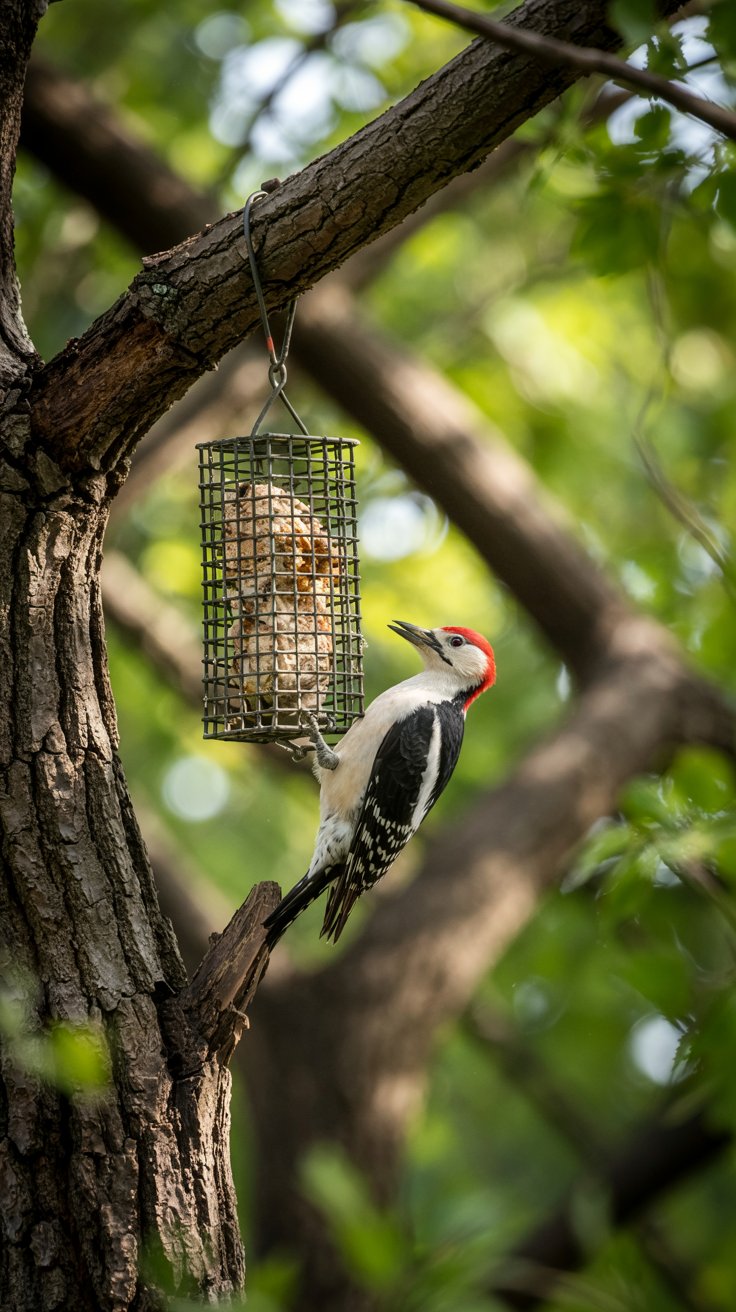
Woodpeckers love suet! These fatty blocks provide high-energy food that woodpeckers can’t resist. Simply hang a wire-mesh cage feeder from a tree branch or pole, and you’ll soon attract these beautiful birds to your yard.
Suet is especially important in winter when insects are scarce. It helps woodpeckers maintain their energy levels during cold months. You can buy pre-made suet cakes at most garden centers, or try making your own like “Zick Dough,” an energy-rich recipe created by nature writer Julie Zickefoose.
Place your suet feeder near trees where woodpeckers naturally hang out. The wire cage design keeps the suet secure while allowing woodpeckers to grip and peck safely.
Why We Love It: Suet feeders bring stunning birds like Downy, Hairy, and Red-headed Woodpeckers right to your yard! They’re low-maintenance, affordable, and work year-round. Plus, watching woodpeckers cling to the cage while feeding is truly entertaining.
3) Add a Nectar Feeder for Hummingbirds

Want to add some sparkle to your backyard? Hummingbirds are like flying jewels that can bring your garden to life! Adding a special feeder just for these tiny visitors is super easy.
You can make your own nectar by mixing 1 part sugar with 4 parts boiling water. Stir until the sugar dissolves completely, then let it cool before filling your feeder. No need for red dye or honey – plain sugar water works best!
Hang your feeder in a partly shaded spot where you can see it from your window. These tiny birds have amazing memories and will return to reliable food sources again and again.
Remember to clean your feeder every 3-5 days, especially in hot weather. Fresh nectar prevents harmful mold that could hurt your hummingbird friends.
Why We Love It: Hummingbirds are fascinating to watch with their incredible hovering abilities and lightning-fast wings. They’re also helpful pollinators and natural pest controllers since they eat small insects along with nectar!
4) Provide Fresh Water in a Birdbath

Birds need water just as much as they need food! A birdbath isn’t just a pretty garden feature—it’s a vital resource for our feathered friends. Birds use water for drinking and bathing, which helps them keep their feathers in good condition.
Place your birdbath in a shady spot to keep the water cooler and reduce algae growth. Make sure it’s not too deep—birds prefer shallow water that’s about 1-2 inches deep with gently sloping sides.
Change the water every 2-3 days to keep it fresh and clean. During winter, consider adding a birdbath heater to prevent freezing. In summer, a solar-powered fountain attachment can create moving water that attracts even more birds!
Why We Love It: Birds that might not visit your feeders will still come for water! The sound of moving water is especially attractive to birds, and watching them splash around during bath time is pure entertainment. Plus, you’re helping birds stay healthy by providing clean water.
5) Plant Native Shrubs to Attract Insects for Birds
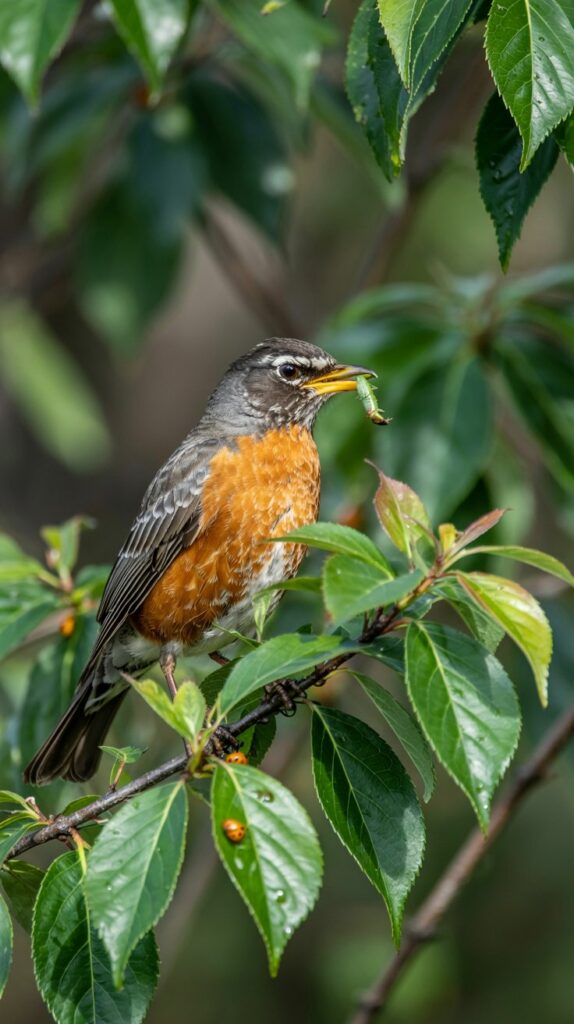
Want to turn your yard into a bird paradise? Native shrubs are your secret weapon! These plants have evolved alongside local birds and bugs, creating the perfect natural buffet for your feathered friends.
Choose shrubs like serviceberry, wild bergamot, or purple coneflowers. These plants support caterpillars, beetles, and other tasty insects that birds love to snack on.
You’ll be amazed at how quickly birds discover your insect-rich shrubs. Even species that don’t visit feeders will stop by for these natural treats. Plus, many native shrubs offer bonus berries and seeds!
No need to spray chemicals – let nature’s balance keep pest populations in check. Your birds will handle bug control while you enjoy the show.
Why We Love It: Native shrubs require less water and maintenance than exotic plants while providing year-round bird habitat. You’ll save money on bird food while creating a more sustainable yard ecosystem!
6) Keep Feeders Clean to Prevent Disease
Just like we wash our dishes, bird feeders need regular cleaning too! Dirty feeders can spread diseases among our feathered visitors, turning your bird-friendly yard into a health hazard.
According to experts, you should clean your feeders about every two weeks. This simple routine prevents harmful bacteria and mold from growing on leftover seeds and bird droppings.
To clean properly, scrub off any visible debris first. Then wash the feeder with a 10% bleach solution (one part bleach to nine parts water). Make sure to rinse thoroughly so no bleach residue remains.
Don’t forget about birdbaths! These need regular cleaning too, as standing water can quickly become a breeding ground for bacteria and algae.
Why We Love It: Regular cleaning shows you care about your birds’ health, not just their hunger! Plus, cleaner feeders attract more birds since they instinctively avoid dirty feeding areas that could make them sick.
Picture this: A person wearing garden gloves scrubbing a bird feeder over a bucket of soapy water, with clean feeders drying on a towel nearby, all set against a sunny backyard scene.
7) Use a Variety of Seeds to Attract Different Species
Did you know that different birds have different food preferences? It’s true! By offering several types of seeds, you’ll welcome a wider range of feathered friends to your yard.
Black-oil sunflower seeds are a must-have. They attract an impressive lineup including cardinals, finches, woodpeckers, grosbeaks, and nuthatches. These seeds have thin shells that most birds can crack open easily.
Nyger (thistle) seeds are tiny but mighty! They’re perfect for bringing in smaller birds like goldfinches, siskins, and juncos. You’ll need a special feeder with small openings for these seeds.
Mix it up with millet, safflower, and cracked corn to invite even more diversity. Each seed type appeals to different bird species based on their taste preferences, beak shapes, and nutritional needs.
Why We Love It: Offering a seed buffet creates a lively backyard bird community! You’ll enjoy watching different species with their unique behaviors and colors all year round. Plus, it’s fascinating to observe which birds prefer which seeds.
8) Avoid Offering Bread as it Lacks Nutrition
Have you ever thought about tossing bread to birds? Think again! Bread is like junk food for our feathered friends. It fills their tummies but doesn’t give them the nutrients they need to stay healthy.
When birds eat too much bread, they might feel full but actually be malnourished. It’s like if you only ate cotton candy all day – your stomach wouldn’t growl, but your body wouldn’t be happy!
Bread can also get moldy quickly when left outside, which can make birds sick. Plus, uneaten bread might attract unwanted visitors like rats or mice to your yard.
Instead, offer birds natural foods like seeds, nuts, or fruits. These foods provide the proteins, fats, and vitamins birds need, especially during winter when food is scarce.
Why We Love It: We love this tip because it helps birds truly thrive rather than just survive! By skipping the bread, you’re showing real care for your backyard visitors and supporting their long-term health.
9) Place Feeders at Different Heights for Variety
Want to turn your yard into a bird paradise? Try setting up feeders at different heights! Birds have preferences about where they feel comfortable eating.
Some birds like to feed up high, while others prefer to be close to the ground. By mixing up your feeder heights, you’ll attract a wider variety of feathered friends to your backyard.
Ground-feeding birds like doves and juncos won’t typically use hanging feeders. They prefer platform feeders or trays placed low to the ground.
Meanwhile, finches and chickadees often feel safer feeding higher up. Try placing some feeders 5-10 feet off the ground near trees or shrubs for these birds.
Why We Love It: Having feeders at multiple heights creates a more natural feeding environment that mimics how birds feed in the wild. You’ll get to observe different species and their unique behaviors all in one yard!
10) Install a Squirrel Baffle to Protect Your Feeders
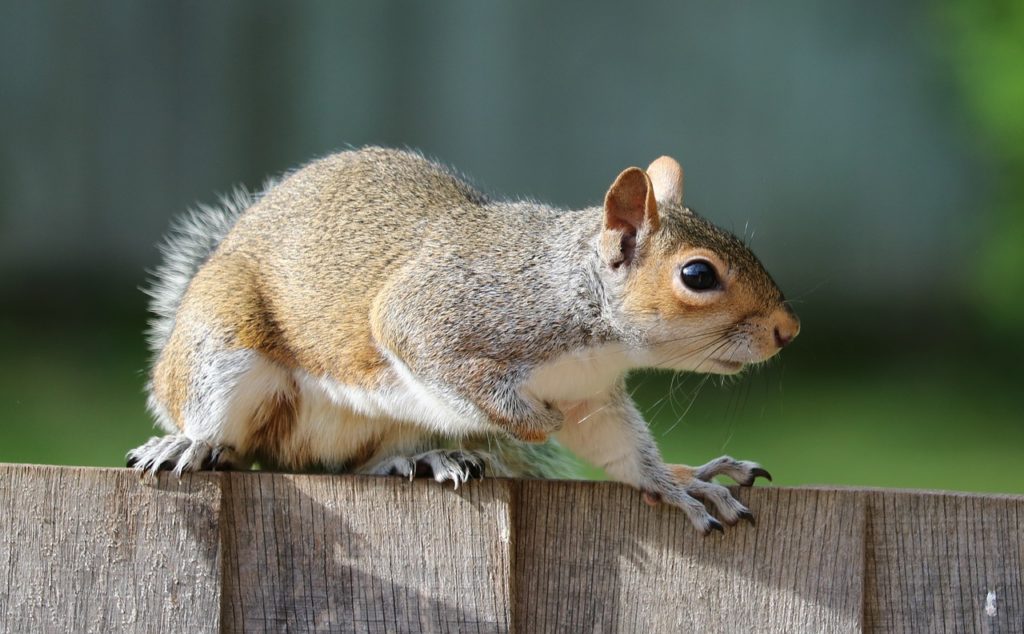
Squirrels are clever little thieves that can raid your bird feeders in no time! A squirrel baffle is your secret weapon in this backyard battle. These simple devices prevent squirrels from climbing up poles or hanging from above to reach your bird seed.
Wrap-around baffles are super easy to install – just place them around your feeder pole without any special tools. They create a physical barrier that blocks squirrels, raccoons, and chipmunks from climbing up to the food source.
Some folks get creative with DIY solutions. One clever dad installed angled plexiglass plates like a roof on top of his feeder, causing squirrels to slide right off. Others use a simple slinky wrapped around the pole!
Why We Love It: Baffles save you money on bird seed that would otherwise end up in squirrel bellies. They’re also fun to watch when squirrels try (and fail) to figure them out. Plus, they’re a humane solution that doesn’t harm the squirrels.
11) Rotate Your Bird Food to Keep it Fresh
Just like you wouldn’t want to eat stale cereal, birds prefer fresh food too! Seeds, nuts, and suet can spoil, especially in hot or humid weather. Check your feeders regularly and replace any food that looks moldy, wet, or has been sitting out for too long.
A good rule is to only fill feeders with the amount of food birds can eat in 2-3 days. This prevents waste and keeps your feathered friends healthy. In summer, you might need to replace food more often since heat speeds up spoiling.
Don’t forget to clean out any old hulls or debris that collect in feeders. These can block fresh seeds and create a breeding ground for bacteria that might make birds sick.
Why We Love It: Rotating food keeps birds safe from harmful molds and bacteria while reducing waste in your yard. Plus, you’ll notice birds visiting more often when they know they’ll find fresh, tasty treats!
12) Choose Feeders With Drainage to Prevent Mold
Water and bird food don’t mix well! When rainwater gets trapped in your bird feeder, it creates a perfect place for mold to grow. This can make birds sick and ruin your expensive birdseed.
Look for feeders with small drainage holes on the bottom. These simple openings allow water to flow out instead of collecting inside. Your seed will stay drier and fresher longer.
Some feeders also have ventilation systems that let air circulate. This helps prevent moisture buildup even on humid days. The best designs have both drainage and ventilation working together.
Plastic feeders usually have better drainage options than wooden ones. Metal feeders can work well too, as long as they have proper drainage holes.
Why We Love It: Feeders with good drainage save you money on wasted seed and protect bird health. You’ll spend less time cleaning and more time enjoying your feathered visitors. Plus, you’ll avoid the frustration of discovering a moldy, unusable feeder after a rainy day!
